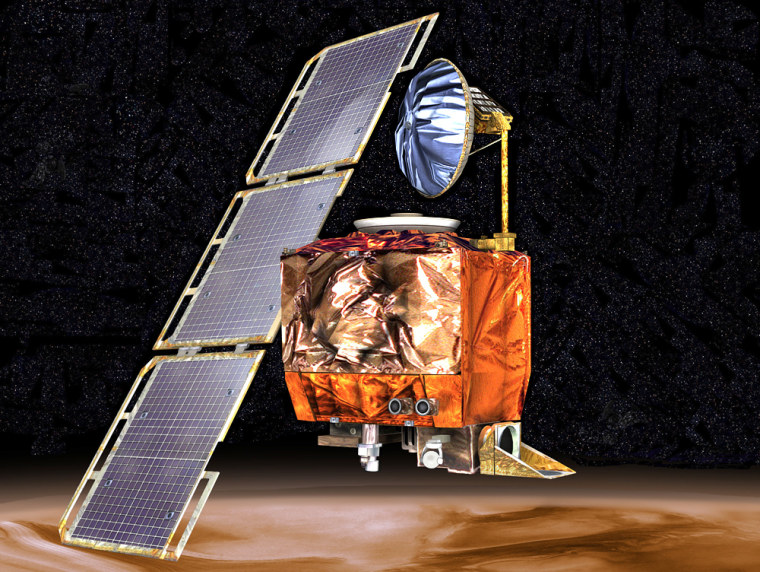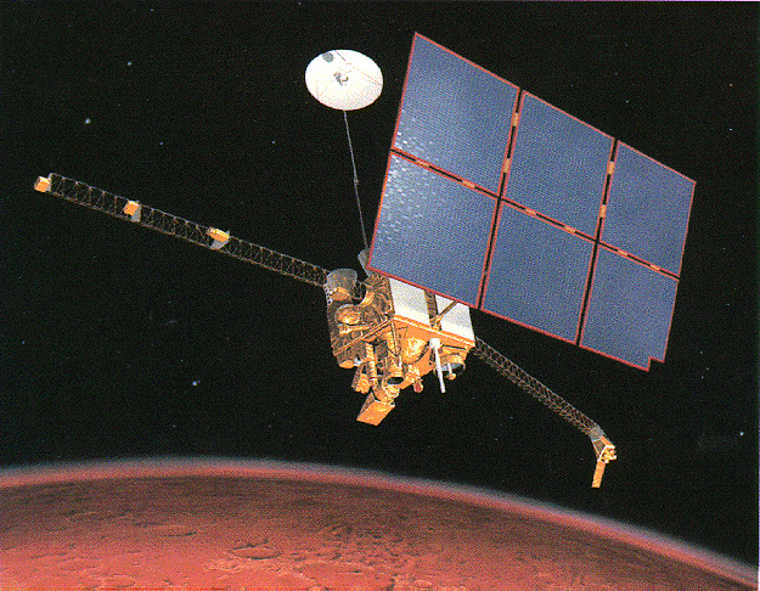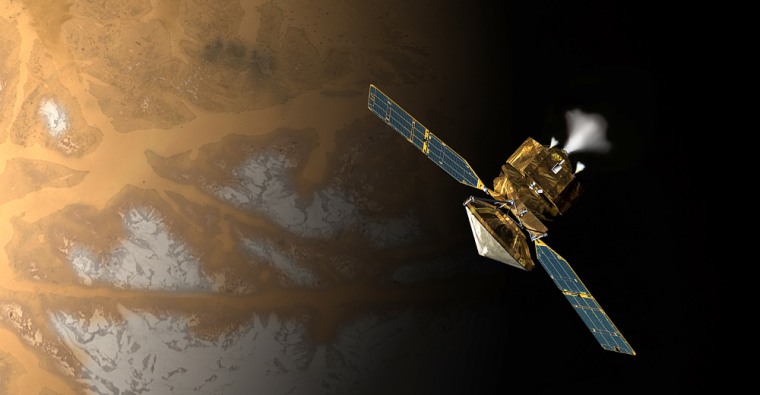In the early years of interplanetary exploration, probes to Mars failed often, and sometimes for reasons that weren't clear. To combat disappointment with humor, space engineers developed a fantasy folklore of outer space in the "Here Be Dragons" motif of ocean voyagers from half a millennium earlier. The mythical sea serpent on the route to Mars was called "the Great Galactic Ghoul."
In the late 1960s and early 1970s, space teams strove to build probes that could survive or outwit the Ghoul's malevolent hunger. Of course, engineers knew that the creature was only a comical personification of the hazards Mars had in abundance. The simplest flight paths to the Red Planet required months of travel. Radio communication was weak, with signal gaps that lasted large fractions of an hour.
Such challenges have long since been overcome. But as Earth's latest emissary, the Mars Reconnaissance Orbiter, hurtles toward its arrival in orbit around Mars on Friday, you may hear once again from some quarters that Mars is "hard," and that failures are only to be expected in such difficult endeavors.
Mars Reconnaissance Orbiter stands a good chance of dodging the Ghoul this time around: It will arrive in orbit using a technique that has worked before — starting with a rocket burn to slow down and enter a widely looping orbit, then skimming the atmosphere repeatedly to further lower that orbit. It has a well-honed suite of scientific instruments for a mission agenda that includes the sharpest-ever photo survey of the planet's surface.
Best of all, its designers, builders and operators are armed with the lessons learned from previous Mars missions, both successful and disastrous.
When bad things happen to good orbiters
Two of NASA's biggest debacles involving Mars orbiters occurred in the 1990s, long after the Great Galactic Ghoul was supposed to have been conquered. In 1993, Mars Observer fell silent only days before its scheduled arrival. Six years later, Mars Climate Orbiter passed behind the planet during its slowdown rocket burn, and never came out the other side.
The 1999 failure is the one most deeply wrapped in a new aura of space folklore. That was the space probe that was supposedly lost because workers mixed up metric and English units of measurement. As a result, so the story goes, they inadvertently steered the probe too close to Mars, and it burned up while skimming the planet's thin atmosphere.
Aside from the late-night TV talk show laughs at the expense of the hapless workers, the story had the virtue of being easy to understand, with well-defined fall guys. But the story was also wrong, or at best only partially true.
The people ultimately at fault were too high in NASA to be "outed," it seems. Mistakes were made, and an expensive Mars probe was lost — but the root cause of the failure went largely unpublicized by NASA and remains so to this day. It turns out there had indeed been a mixup over measurement units. But the reason this mistake ultimately doomed the mission wasn't the fault of those directly involved at that level.
Mars Climate Orbiter had been designed with a single solar panel that on the long cruise between worlds inadvertently acted like a small "solar sail." Photon pressure gradually torqued the spacecraft away from its preferred orientation, and from time to time small rocket thrusters had to be turned on briefly to push it back to face the desired direction.
Because of where they were installed on the probe, those thrusters didn't just make the spacecraft spin gently — they also imparted a smaller, but not negligible, push that altered its path through space. It was a data table listing the amount of this disturbing "push' for each thruster, originally calculated in newtons (the metric unit of force) but later interpreted in pounds-force (the English unit equivalent), that began the process that ended in tears.
Problem discovered too late
Because the probe had been a showcase for "faster, better, cheaper" space missions, the revolutionary philosophy espoused at the time by NASA Administrator Dan Goldin and touted by Vice President Al Gore, standard levels of double checking had been eliminated. The space navigators who might have anticipated the problem, or even identified it, were not budgeted to begin participating in the mission soon enough.

According to private contacts within NASA's Jet Propulsion Laboratory, the "units" mistake was noticed, since it caused some of the midcourse corrections to be larger than they should have been. The navigators even correctly guessed that the tables were in error by about a factor of four — the actual ratio between the two units of measurement. Unfortunately, they were never given the time or the resources to track down the cause.
The navigators reportedly voiced their uneasiness during the probe's final approach to Mars — only to be told they had to "prove we are off course" before the path could be altered.
The proper approach to space safety is to assume a hazard is present until you can prove it is absent, and only then to proceed. In this case — as in the case of the shuttle Challenger, where the doubting engineers were ordered to prove the seal wouldn't work at record low temperatures — the presence of doubt should have required verification. Instead, the uncertainty was used as an excuse to avoid even trying to get verification.
In the end, cutting corners in space led to cutting the corner at Mars too closely. In the final hours of the approach, as better navigation data poured in, the control team was horrified to see the predicted path swerve deeper into the atmosphere. But nothing could be done except hope for a miracle, and to withhold those anxieties from the public — then and later.
Swallowed whole by the Ghoul?
The 1993 loss of Mars Observer is similarly shrouded in myths and half-truths. This is the probe that suddenly disappeared just short of arriving at Mars, according to the modern folklore. Weird theories about hostile space forces, phantom meteor swarms and even government cover-up conspiracies have been wrapped around this mishap.
Mars Observer, of course, never "disappeared" at all. It just stopped sending radio signals, which was the only way controllers back on Earth could know what was happening. And the timing of this silence was a crucial clue to what had gone wrong. It fell silent on Aug. 21, 1993, just three days before it was due to enter Martian orbit.
This was just after small explosive bolts had been fired to pressurize the rocket thruster fuel tanks that would be used in the braking rocket burn. The probe's transmitter had been commanded off because it was feared that the impact of the small detonations might break the heated cathode in the radio's amplifier.
In hindsight, investigators concluded that the failure most probably was caused by the inadvertent mixing and the reaction of nitrogen tetroxide and monomethyl hydrazine within the titanium pressurization tubing. These two chemicals are hypergolic propellants, designed to explode spontaneously when mixed in a rocket chamber. If mixed somewhere else, they explode with equal enthusiasm but less happy results.

The explosive fuel was supposed to have been safely isolated inside a pair of tanks, but the valve seals probably leaked. Based on tests performed at the Jet Propulsion Laboratory, the review board concluded that "an energetically significant amount" (NASA talk for "enough to blow up") of the nitrogen tetroxide had gradually leaked through check valves and accumulated in the tubing during the spacecraft's 11-month flight to Mars.
The report especially criticized NASA for relying on hardware originally designed for near-Earth missions. To save money, NASA tried to redesign a Pentagon spacecraft that had been built for launching into geostationary Earth orbit. The original mission called for a six-hour rise to orbit, not the almost yearlong cruise needed to get to Mars, and was therefore "fundamentally different from the interplanetary Mars Observer mission," the report said.
The idea of saving money by reusing similar-looking space hardware is a fallacy based on the mistaken impression that the costliest component of a spacecraft is the materials of which it is made. The biggest cost is actually the human effort required to verify that all parts work together properly and to make sure the reliability levels of all the components and combinations of components stays high enough. Thus, using a short-lived fuel tank valve that has to last 1,000 times longer than the lifetime for which it was designed will ultimately cost far more, take far longer, and be less safe.
In 1993, NASA learned that lesson from Mars Observer's death. Then, in 1999, the loss of Mars Climate Orbiter taught space engineers that making convenient safety assumptions and taking budget-driven shortcuts would cost far more in the end.
Happily, the team that built Mars Reconnaissance Orbiter were smart enough to incorporate these lessons from the start, with plenty of ground tests, independent reviews and stringent reliability standards. The Ghoul could still strike, of course. But if it does, it won't be because NASA has forgotten what it learned from those past orbiter failures.
Sadly, the public remains largely in the dark about the lessons from Mars — which, after all, can be applied to earthly matters as well as space shots. If you check NASA's online postmortem on Mars Climate Orbiter, you'll learn only that "engineers concluded that the spacecraft entered the planet's atmosphere too low and probably burned up." For Mars Observer, that "the mission ended with disappointment on August 22, 1993, when contact was lost with the spacecraft shortly before it was to enter orbit around Mars."
Taxpayers paid for these lessons, too, and NASA needs to share them more openly and more thoroughly.
NBC News space analyst James Oberg spent 22 years at NASA's Johnson Space Center as a Mission Control operator and an orbital designer.
